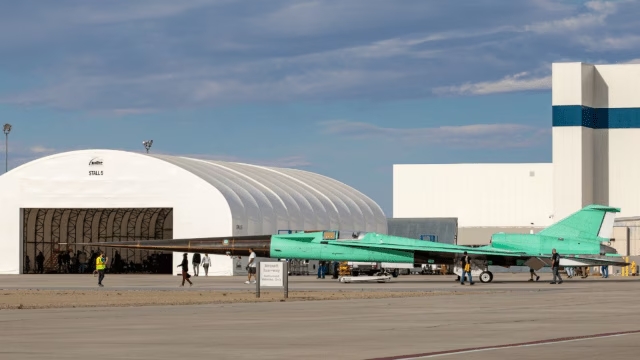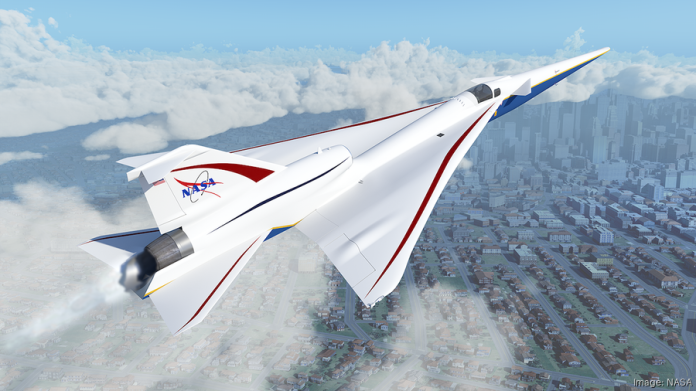NASA has recently powered up its X59 supersonic jet, a potential game-changer in the future of commercial supersonic travel. Developed in partnership with Lockheed Martin, the X59 has undergone testing from October to February. This advanced jet is powered by a single modified F414-GE-100 engine, designed to produce a quieter supersonic experience by generating a “sonic thump” instead of the traditional loud sonic boom.
For those unfamiliar, when an aircraft exceeds the speed of sound (1,234 km/h or Mach 1), it creates a sharp, thunderous sonic boom that can startle people on the ground and even break windows. While past commercial supersonic flights like the Concorde garnered attention, they were criticized for being fuel-inefficient and costly. Additionally, communities near Concorde’s flight paths often complained about the noise, leading to the plane’s retirement in 2003.
The X59 aims to address these issues by mounting the engine above the aircraft, rather than on the bottom or sides. According to NASA, this innovative design allows the jet to generate a quieter “sonic thump,” which could drastically reduce the noise heard by people on the ground.

The X59 supersonic jet, developed by NASA in collaboration with Lockheed Martin, is designed to reach altitudes of up to 55,000 feet (16,764 meters) and achieve a top speed of 1,489 km/h. While the aircraft is still in the testing phase, NASA has not yet disclosed when the X59 will take its first official flight. However, once it is ready for takeoff, the jet will undergo a series of flight tests to gather data on how its unique sonic thump impacts people on the ground. These demonstrations are scheduled for 2027, and the goal is to better understand how the aircraft’s noise can be mitigated during commercial operations.
NASA’s tests with the X59 are focused on studying the jet’s quieter supersonic characteristics. Unlike conventional supersonic jets that create a disruptive sonic boom, the X59 is engineered to produce a “sonic thump,” a much softer sound that NASA hopes will be less startling to people living beneath its flight path. This innovative design could potentially pave the way for a future where commercial supersonic travel becomes a reality again, without the noise complaints that doomed the Concorde.
The X59’s flight tests will be critical in determining whether this quieter supersonic technology can be scaled for commercial use. If successful, it could lead to the development of a new generation of supersonic aircraft that are both efficient and acceptable to communities. The findings from these tests will also be pivotal in shaping regulations around supersonic flight over land, an area that remains controversial due to concerns about noise pollution.
NASA is not alone in its pursuit of reviving commercial supersonic jets. Other aerospace companies are also making strides in this field. Recently, Boom Supersonic, an aerospace company, made headlines by successfully flying its experimental XB-1 aircraft. During a single test flight, the XB-1 surpassed Mach 1 speeds three times, demonstrating the potential for future supersonic commercial aircraft. Boom Supersonic’s progress highlights the growing interest and competition in developing faster, more efficient air travel.
Both NASA and Boom Supersonic are working towards similar goals: making supersonic travel feasible and practical for commercial airlines. However, while NASA focuses on reducing the noise impact of supersonic flight, Boom Supersonic is concentrating on building a fleet of supersonic airliners that could carry passengers at speeds over Mach 2. The race to revive supersonic air travel is on, and it’s clear that these advancements will shape the future of aviation in the coming years.



 Viesearch - The Human-curated Search Engine
Blogarama - Blog Directory
Web Directory gma
Directory Master
http://tech.ellysdirectory.com
8e3055d3-6131-49a1-9717-82ccecc4bb7a
Viesearch - The Human-curated Search Engine
Blogarama - Blog Directory
Web Directory gma
Directory Master
http://tech.ellysdirectory.com
8e3055d3-6131-49a1-9717-82ccecc4bb7a